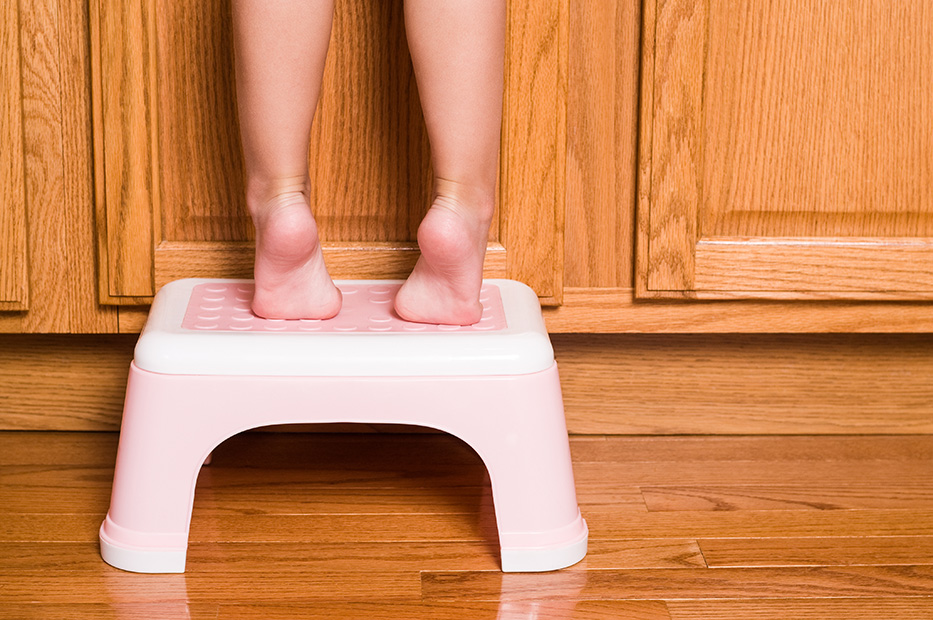You’ve found your new home and are thrilled with the anticipation of moving in. You’ve got ideas about decorating, landscaping, and furnishing your new home to your exact specifications, but what about childproofing?
The Centers for Disease Control reports that each year about 9.2 million children sustain an accidental injury resulting in a trip to the emergency room, with an additional 7,300 dying from preventable injury. Taking steps to childproof your home will ensure that the whole family can enjoy it safely.
Childproofing inside your home
Your child experiences the world from a vastly different perspective than you do – namely, from a much lower height. Getting down on your hands and knees and investigating from that vantage point will give you a better idea of dangers below knee-level.
In the kitchen and bathroom, this may be cleaning solutions or appliances with cords. Move them to higher ground or install childproof cupboard and drawer latches. Replace electrical outlet panels with those that slide over outlets when not in use. Install childproof clamps on your toilets so a curious toddler can’t climb or topple in, and make sure all medications are locked up, out of reach, or have childproof caps.
Around your living room and bedrooms, install bumpers on sharp corners of tables or chairs – this could be as simple as wrapping them in foam rubber and securing with packaging tape. Check your taller furniture, such as armoires and TV cabinets, for stability. Make sure they can’t be pulled down by an unsteady toddler learning to walk. Bolt heavy furniture like bookcases and headboards to walls whenever possible, and use electrical tape to tamp down and secure any extension cords running along the floor.
If you have floor lamps, consider storing them until your child is steady enough on their feet to be able to navigate around them. Lamps, plants, and knickknacks should all be secured or removed. If you have curtains or blinds with long cords, tie them up out of reach. Infants and toddlers can become entangled in curtain cords and blinds. Avoid placing your baby’s crib near a window, and install locks on any window that can be opened.
In your laundry room, secure washer and dryer machine lids so a child can’t climb in and become trapped. Place detergents, bleaches, and solutions out of reach of curious hands and mouths.
If there are parts of the house you don’t want your child to access, a closed door is safer and more secure than a gate. If you do buy a baby gate, make sure it’s certified by the Juvenile Products Manufacturer’s Association, keeping your child’s stage of development in mind. A gate that screws into the wall is the most secure option, as tension gates might work to contain a crawler but become a hazard when your baby starts climbing and walking.
Childproofing outside your home
Examine the exterior of your house for the same pitfalls as its interior – accessible outlets, unsteady furniture, sharp corners, cords, lines, or hoses that could cause injury. If your home comes with a pool or hot tub, install a locking cover, childproof pool fencing, or a fixed gate that prevents child access to the area. Fortify balcony and deck railings, and shore up spaces between slats that your child could squeeze through or get a head or other body part stuck in.
If you have landscaping or a backyard garden, make sure your plants and flowers are not toxic or poisonous. In the garage or carport, keep chemicals and paint on high counters or in secured lockers, or prevent access to these areas altogether.
Have an expert childproof your home
If you have the means, you can hire someone to childproof your house for you. The International Association for Child Safety maintains a database of Child Safety Consultants and can connect you with a professionally certified child safety expert in your area.
When it comes to staying safe, your vigilance is your child’s best protection. By taking the time to childproof your home and implement these safety measures, the space should be more secure for all residents and visitors to the home.
This post was written for Realty Executives by Estelle Weber, a freelance writer living in Los Angeles. You can read more of her work here.

